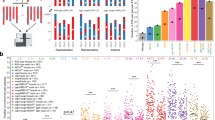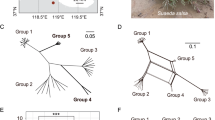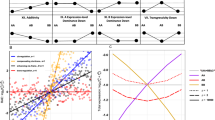Abstract
Using data from the in situ hybridisation of the giant chromosomes from salivary glands, we have estimated the chromosomal distribution of copia, mdg-1 (a copia-like element), I and P (two elements involved in hybrid dysgenesis systems) in hybrids from a 6 × 6 diallel cross between highly inbred lines of Drosophila melanogaster. The larvo-pupal viability of the hybrids was found to be significantly correlated with the maternal copy number of the I and P elements. Hybrid viability can thus be predicted from the copy number of certain elements in the maternal inbred lines, and not from the degree of heterozygosity of the hybrid genomes.
Similar content being viewed by others
Article PDF
References
Belyaeva, E S P, Pasyukova, E G, Gvozdev, V A, Ilyin, Y V, and Kaidanov, L Z. 1982. Transpositions of mobile dispersed genes in Drosophila melanogaster and fitness of stocks. Mol Gen Genet, 185, 324–328.
Biel, S W, and Hartl, D L. 1983. Evolution of transposons: natural selection for Tn5 in Escherichia coli K12. Genetics, 103, 581–592.
Biémont, C. 1986. Polymorphism of the mdg-X and I mobile elements in Drosophila melanogaster. Chromosoma, 93, 393–397.
Biémont, C, and Aouar, A. 1987. Copy-number dependent transpositions and excisions of the mdg-l mobile element in inbred lines of Drosophila melanogaster. Heredity, 58, 39–47.
Biémont, C, Aouar, A, and Arnault, C. 1987. Genome reshuffling of the copia element in a Drosophila melanogaster inbred line. Nature, 329, 742–744.
Biémont, C, Belyaeva, E S P, Pasyukova, E F, and Kogan, G. 1985. Mobile gene localisation and viability in a natural population of Drosophila melanogaster. Experien-tia, 41, 1474–1476.
Biémont, C, and Gautier, C. 1987. Mdg-l mobile element heterozygosity in Drosophila melanogaster. Heredity, 58, 167–172.
Biémont, C, and Gautier, C. 1988. Localization polymorphism of mdg-l, copia, I and P mobile elements in genomes of Drosophila melanogaster, from data of inbred lines. Heredity, 60, 335–346.
Biémont, C, and Terzian, C. 1986. Regulation in the number of mdg-l mobile elements in inbred Drosophila melanogaster. Genetica, 71, 161–165.
Brégliano, J C, and Kidwell, M G. 1983. Hybrid dysgenesis determinants. In Shapiro, J. A. (ed.) Mobile Genetic Elements, Academic Press.
Chao, L, Vargas, C, Spear, B B, and Cox, E C. 1983. Transposable elements as mutator genes in evolution. Nature, 303, 633–635.
Charlesworth, B, and Charlesworth, D. 1983. The population dynamics of transposable elements. Genet Res, 42, 1–27.
Di Nocera, P P, and Casari, G. 1987. Related polypeptides are encoded by Drosophila F elements, I factors, and mammalian LI sequences. Proc Natl Acad Sci USA, 84, 5843–5847.
Emori, T, Shiba, T, Kanaya, S, Inouye, S, Yuki, S, and Saigo, K. 1985. The nucleotide sequences of Copia-related RNA in Drosophila virus-like particles. Nature, 315, 773–776.
Falconer, D S. 1981. Introduction to Quantitative Genetics, 2nd edn. Oliver&Boyd, Edinburgh.
Fawcett, D H, Lister, C K, Kellet, E, and Finnegan, D J. 1986. Transposable elements controlling I-R hybrid dysgenesis in D. melanogaster are similar to mammalian LINEs. Cell, 47, 1007–1015.
Fitzpatrick, B J, and Sved, J A. 1986. High levels of fitness modifiers induced by hybrid dysgenesis in Drosophila melanogaster. Genet Res, 48, 89–94.
Frei, B, Stuber, C W, and Goodman, M M. 1986. Use of allozymes as genetic markers for predicting performance in maize single cross hybrids. Crop Science, 26, 37–42.
Gowen, J W. 1952. Heterosis. Gowen, J. (ed.). Iowa State Coll. Press, Ames, Iowa.
Gvozdev, V A, Belyaeva, E S P, Ilyin, Y U, Amosova, I S, and Kaidanov, L Z. 1981. Selection and transposition of mobile dispersed genes in Drosophila melanogaster. Cold Spring Harbor Symp Quant Biol, 45, 673–685.
Hartl, D L, Medhora, M, Green, L, and Dykhuizen, D E. 1986. The evolution of DNA sequences in Escherichia coll Phil. Trans R Soc London, 312, 191–204.
Ilyin, Y V, Chmeliauskaite, V G, and Georgiev, G P. 1980. Double-stranded sequences in RNA of Drosophila melanogaster: relation to mobile dispersed genes. Nucleic Acid Res, 8, 3439–3457.
Langer-Safer, P R, Levine, M, and Ward, D C. 1982. Immunological method for mapping genes on Drosophila polytene chromosomes. Proc Natl Acad Sci USA, 79, 4381–4385.
Lamkey, K K, Hallauer, A R, and Kahler, A L. 1987. Allelic differences at enzyme loci and hybrid performance in maize. J Heredity, 78, 231–234.
Lewontin, R C. 1985. Population genetics. Ann Rev Genet, 19, 81–102.
Mackay, T F C. 1986. Transposable element-induced fitness mutations in Drosophila melanogaster. Genet Res, 48, 77–87.
Mather, K, and Jinks, J L. 1971. Biometrical Genetics. Chapman and Hall, London.
Moll, R H, Lonnquist, J H, Vélez Fortuno, J, and Johnson, E C. 1965. The relationship of heterosis and genetic divergence in maize. Genetics, 52, 139–144.
O'Hare, K, and Rubin, G M. 1983. Structures of P transposable elements and their sites of insertion and excision in the Drosophila melanogaster genome. Cell, 34, 25–35.
Price, S C, Kahler, A L, Hallaljer, A R, Charmley, P, and Giegel, D A. 1986. Relationships between performance and multilocus heterozygosity at enzyme loci in single cross hybrids of maize. J Hered, 77, 341–344.
Rigby, P W, Dieckmann, M, Rhodes, C, and Berg, P. 1977. Labeling dexoyribonucleic acid to high specific activity in vitro by nick translation with DNA polymerase I. J Mol Biol, 113, 237–251.
Snyder, M, and Doolittle, W F. 1988. P elements in Drosophila: selection at many levels. Trends in Genet, 4, 147–149.
Strauss, S H. 1986. Heterosis at allozyme loci under inbreeding and crossbreeding in Pinus attenuata. Genetics, 113, 115–134.
Tchurikov, N A, Ilyin, Y V, Skryabin, K G, Ananiev, E V, Bayev, A A, Krayev, A S, Zelentsova, E S, Kulguskin, V V, Lyubomirskaya, N V, and Georgiev, G P. 1981. General properties of mobile dispersed genetic elements in Drosophila. Cold Spring Harbor Symp Quant Biol, 45, 655–665.
Visscher, S N. 1971. Studies on the embryogenesis of Aulocara elliotti (Orthoptera, Acrididae). Ill Influence of maternal environment and ageing on development of the progeny. Annu Entomol Soc Amer, 64, 1057–1074.
Wolf, G, and Rimpau, J. 1977. Evidence for cytoplasmic control of gene expression in higher plants. Nature, 265, 470–472.
Yukuhiro, K, Harada, K, and Mukai, T. 1985. Viability mutations induced by the P elements in Drosophila melanogaster. Jap J Genet, 60, 531–537.
Author information
Authors and Affiliations
Rights and permissions
About this article
Cite this article
Biémont, C., Aouar, A., Gautier, C. et al. Hybrid viability is correlated with the I and P mobile element copy numbers of the maternal inbred line in Drosophila melanogaster. Heredity 62, 301–305 (1989). https://doi.org/10.1038/hdy.1989.43
Received:
Issue date:
DOI: https://doi.org/10.1038/hdy.1989.43
This article is cited by
-
Population genetics of transposable DNA elements
Genetica (1992)



